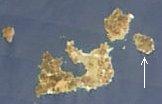Polyaigos on:
[Wikipedia]
[Google]
[Amazon]
 Polýaigos (; ) is an uninhabited
Polýaigos (; ) is an uninhabited
Greek
Greek may refer to:
Anything of, from, or related to Greece, a country in Southern Europe:
*Greeks, an ethnic group
*Greek language, a branch of the Indo-European language family
**Proto-Greek language, the assumed last common ancestor of all kno ...
island
An island or isle is a piece of land, distinct from a continent, completely surrounded by water. There are continental islands, which were formed by being split from a continent by plate tectonics, and oceanic islands, which have never been ...
in the Cyclades
The CYCLADES computer network () was a French research network created in the early 1970s. It was one of the pioneering networks experimenting with the concept of packet switching and, unlike the ARPANET, was explicitly designed to facilitate i ...
near Milos
Milos or Melos (; , ; ) is a volcanic Greek island in the Aegean Sea, just north of the Sea of Crete. It is the southwestern-most island of the Cyclades group.
The ''Venus de Milo'' (now in the Louvre), the ''Poseidon of Melos'' (now in the ...
and Kimolos. It is part of the community of Kimolos (Κοινότητα Κιμώλου). Its name means "many goats", since it is inhabited only by goats. It was mentioned by several ancient geographers: Ptolemy
Claudius Ptolemy (; , ; ; – 160s/170s AD) was a Greco-Roman mathematician, astronomer, astrologer, geographer, and music theorist who wrote about a dozen scientific treatises, three of which were important to later Byzantine science, Byzant ...
, Pliny the Elder
Gaius Plinius Secundus (AD 23/24 79), known in English as Pliny the Elder ( ), was a Roman Empire, Roman author, Natural history, naturalist, and naval and army commander of the early Roman Empire, and a friend of the Roman emperor, emperor Vesp ...
, and Pomponius Mela
Pomponius Mela, who wrote around AD 43, was the earliest known Roman geographer. He was born at the end of the 1st century BC in Tingentera (now Algeciras) and died AD 45.
His short work (''De situ orbis libri III.'') remained in use nea ...
.
Along its longest axis, it is and among its shortest wide. It has a surface area of approx. and a coastal length of . It is very close to the island of Kimolos ( north west from Polyaigos) and to the island of Milos ( west from Polyaigos). There are two mounts, Stroggylo which rises to and Psilo Vouno ().
The island is to a great extent privately owned by the Greek Orthodox church, which sublets parts of it to local herdsmen from the nearby islands of Milos and Kimolos.
Its goat population maintains Polyaigos as a barren island. It has, however, some magnificent beaches, mainly on the southern part of the island, as well as many sea-surface caves, which serve as a refuge to a dwindling population of Mediterranean monk seal
The Mediterranean monk seal (''Monachus monachus'') is a monk seal belonging to the family Phocidae. , it is estimated that fewer than 700 individuals survive in three or four isolated subpopulations in the Mediterranean, (especially) in the A ...
s (''Monachus monachus'').
References
Islands of Greece Cyclades Landforms of Milos (regional unit) Islands of the South Aegean {{SAegean-geo-stub